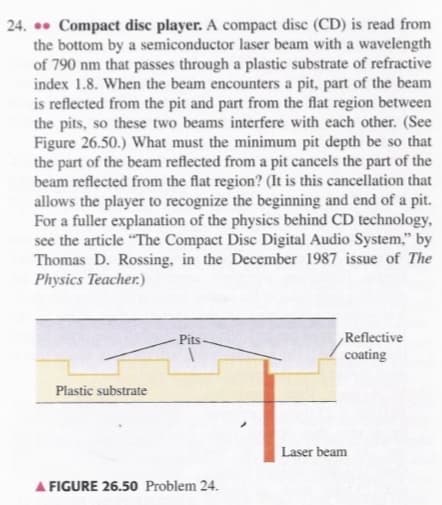24. Compact disc player. A compact disc (CD) is read from the bottom by a semiconductor laser beam with a wavelength of 790 nm that passes through a plastic substrate of refractive index 1.8. When the beam encounters a pit, part of the beam is reflected from the pit and part from the flat region between the pits, so these two beams interfere with each other. (See Figure 26.50.) What must the minimum pit depth be so that the part of the beam reflected from a pit cancels the part of the beam reflected from the flat region? (It is this cancellation that allows the player to recognize the beginning and end of a pit. For a fuller explanation of the physics behind CD technology, see the article "The Compact Disc Digital Audio System," by Thomas D. Rossing, in the December 1987 issue of The Physics Teacher.) Pits- Reflective coating Plastic substrate Laser beam FIGURE 26.50 Problem 24.
24. Compact disc player. A compact disc (CD) is read from the bottom by a semiconductor laser beam with a wavelength of 790 nm that passes through a plastic substrate of refractive index 1.8. When the beam encounters a pit, part of the beam is reflected from the pit and part from the flat region between the pits, so these two beams interfere with each other. (See Figure 26.50.) What must the minimum pit depth be so that the part of the beam reflected from a pit cancels the part of the beam reflected from the flat region? (It is this cancellation that allows the player to recognize the beginning and end of a pit. For a fuller explanation of the physics behind CD technology, see the article "The Compact Disc Digital Audio System," by Thomas D. Rossing, in the December 1987 issue of The Physics Teacher.) Pits- Reflective coating Plastic substrate Laser beam FIGURE 26.50 Problem 24.
Related questions
Question
Ch26,P24

Transcribed Image Text:24. . Compact disc player. A compact disc (CD) is read from
the bottom by a semiconductor laser beam with a wavelength
of 790 nm that passes through a plastic substrate of refractive
index 1.8. When the beam encounters a pit, part of the beam
is reflected from the pit and part from the flat region between
the pits, so these two beams interfere with each other. (See
Figure 26.50.) What must the minimum pit depth be so that
the part of the beam reflected from a pit cancels the part of the
beam reflected from the flat region? (It is this cancellation that
allows the player to recognize the beginning and end of a pit.
For a fuller explanation of the physics behind CD technology,
see the article "The Compact Disc Digital Audio System," by
Thomas D. Rossing, in the December 1987 issue of The
Physics Teacher)
Pits
Reflective
coating
Plastic substrate
Laser beam
A FIGURE 26.50 Problem 24.
Expert Solution
This question has been solved!
Explore an expertly crafted, step-by-step solution for a thorough understanding of key concepts.
This is a popular solution!
Trending now
This is a popular solution!
Step by step
Solved in 2 steps
